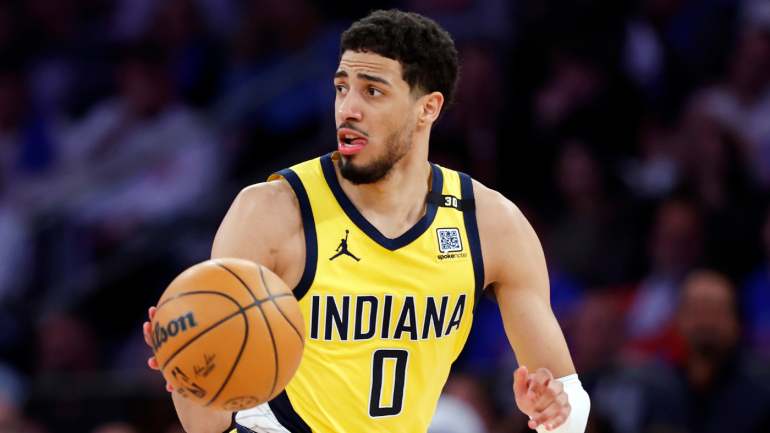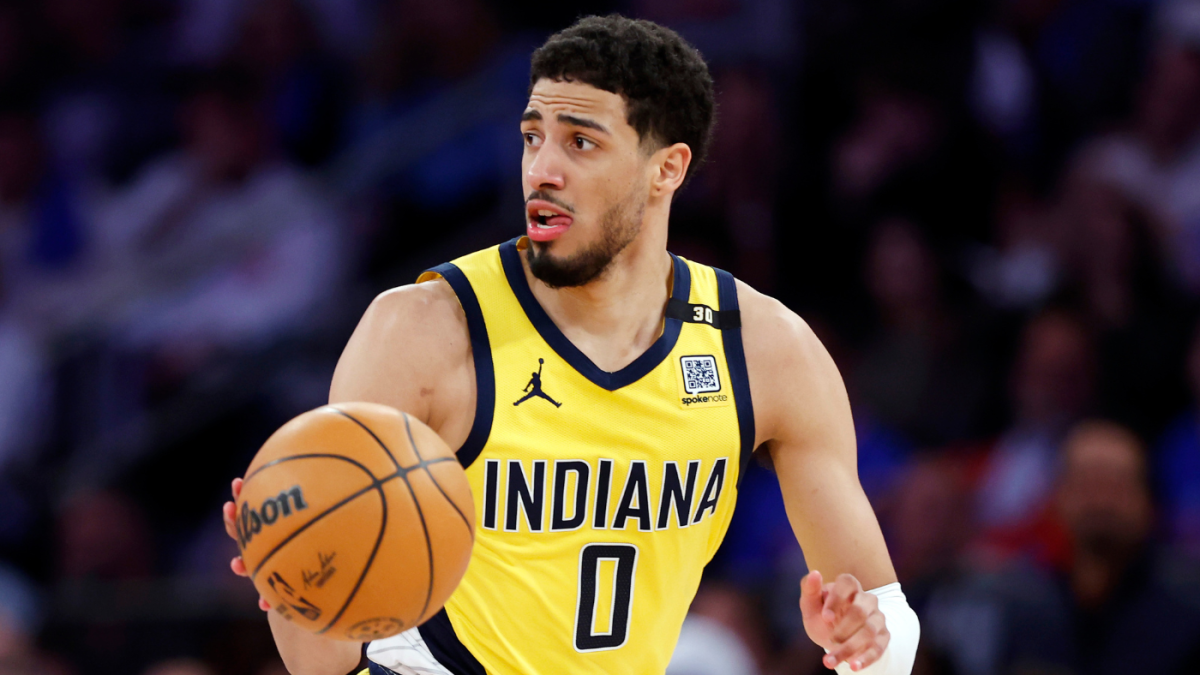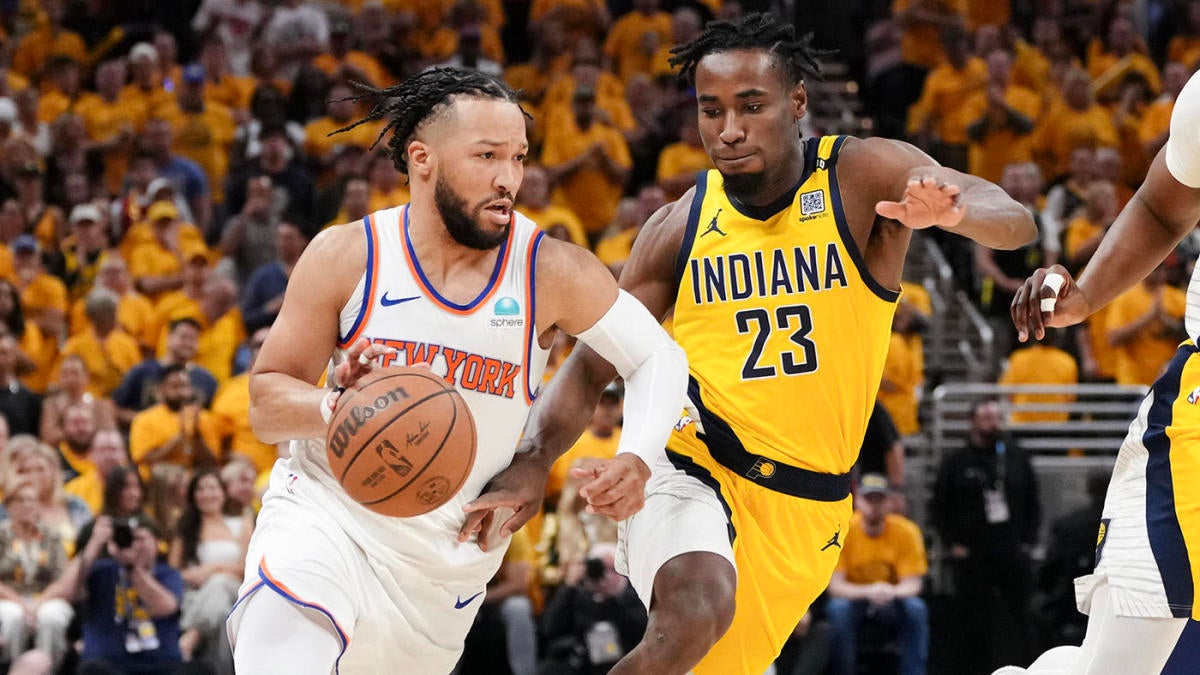
Before the Indiana Pacers' second-round series started, Tyrese Haliburton told me that their matchup with the New York Knicks was "interesting because they're two very contrasting styles." Haliburton is the engine of the league's fastest offense; when Indiana is at full throttle, it overwhelms opponents with quick decisions, movement and misdirection. His counterpart, Jalen Brunson, is the fulcrum of the league's slowest offense; even when New York's shots aren't falling, it grinds out grimy wins by getting stops and extra possessions.
The styles-make-fights aspect of the series, best encapsulated by Yahoo Sports' Dan Devine, who wrote that the Pacers "are built to play beautifully" and the Knicks "are built to destroy something beautiful," made for good preview fodder. In theory, crashing the offensive glass like New York (which grabbed a league-high 33.3% of its own misses in the regular season) is risky against a team that feasts in transition like Indiana (which scored 16.2 fast break points per 100 possessions, No. 4 in the league).
As Rick Carlisle said before Game 1, though, "You can't run until you have the ball." One of the reasons to crash is to slow opponents down, Carlisle said, echoing Orlando Magic coach Jamahl Mosley: If the defense is sending everybody to the boards, nobody is leaking out the other way.
"I think it can go both ways," Haliburton said. "I think that our pace can complicate their offensive rebounding at the same time. Things like pace and stuff like that usually tend to favor who the momentum is [favoring], you know what I mean? If we're rebounding early, we're getting out and running, they gotta think twice about crashing. If they're crashing hard and grabbing every rebound, our pace isn't going to be there."
In other words, the game changes based on who is dictating the terms of engagement.
"I think that's the beautiful part about basketball," Haliburton said.
Through two games, the style of play has largely favored Indiana. In the opener, the Pacers scored 117 points, shot 52.3% from the field and made 38.5% of their 3s, numbers that had Knicks forward Josh Hart lamenting, "That's not winning basketball." Two days later, Indiana scored 121 points, shot 51.6% from the field and made 44.1% of their 3s.
Heading into Game 3 on Friday, Indiana has an offensive rating of 125.3 in the series and is losing the second-chance-points battle by a single point. The slow overall pace numbers -- 98 possessions in Game 1, 92 in Game 2 -- are misleading: the Pacers' average offensive possession has lasted 11.9 seconds (a normal-for-this-time-of-year increase from its regular-season mark of 11.1 seconds), while the Knicks' average offensive possession has lasted 14 seconds (up from 12.5 seconds), per Inpredictable. And yet, New York is up 2-0.
So what is this sorcery? Have the Knicks been touched by the Basketball Gods? Is there some sort of anti-small-market conspiracy? Is New York just beating Indiana at its own game?
The most straightforward answer is that, unless the Pacers play better defense, the style-of-play stuff doesn't necessarily matter. Their high-octane offense was efficient enough to give them a chance to win both games at Madison Square Garden, but they were wobbly enough on the other end to lose them.
It is a massive problem that the Pacers have not been able to bother Brunson, who has burned them both in single coverage and when they've sent a second defender at him. They might have survived his second-half heroics (and their own 3-for-9 shooting from the free throw line in the second half, which, yikes) on Wednesday, though, if they just had clamped down on the Knicks when he was in the locker room. New York scored on six straight possessions without him late in the first quarter, and the teams spent much of the second trading baskets. During his 16 minutes on the bench, Indiana surrendered 125.8 points per 100 possessions.
Viewed from a certain angle, Indiana has not really made this a Pacers-style series. Maybe timing is everything, and maybe none of the numbers above matter as much as Carlisle describing Wednesday's loss as "another case of fourth-quarter loose balls and rebounds that we were unable to secure."
The Knicks rebounded 56.3% of their second-half misses in Game 1 and 60% of their second-half misses in Game 2 (after rebounding half of their fourth-quarter misses in six games against Philadelphia). When every possession feels enormous, there is something demoralizing about forcing a miss and failing to come up with the ball, particularly when the whole world knows that this is a point of emphasis.
The more optimistic perspective, though, is that all of the Pacers' running and gunning just hasn't paid off yet. While Carlisle has dismissed the notion that they're trying to exhaust New York, players have been less reluctant to go there. "Obviously it's no secret that those guys play a lot of minutes," Haliburton said after practice on Tuesday. "We're a deep team, probably the deepest team in the league, so we're trying to use that to our advantage by getting up, pressuring and trying to wear on these guys as much as we can for a seven-game series." That same day, Pascal Siakam said, "We know they're going to slow it down as much as they can, but we just gotta try to speed the game up."
So far, New York has somehow appeared more energized than its playoff opponents in crunch time despite using a seven-man rotation. Maybe Hart can continue to play all 48 minutes without showing any ill effects, and maybe Brunson's foot is totally fine, but Anunoby is out for Game 3, which has to be at least a little scary for the Knicks. Without him (and without forwards Julius Randle and Bojan Bogdanovic, both of whom are out for the season, as is center Mitchell Robinson), coach Tom Thibodeau has to choose between size (Precious Achiuwa) and spacing (Miles McBride), and Brunson will have an even bigger load to carry offensively. The longer the series goes on, the more likely it is that Indiana will be able to win a war of attrition.
All season, the Pacers have run off makes, taken advantage of transition opportunities and pushed the tempo in the halfcourt. This is their identity, and they're not going to stray from it now. With their season effectively on the line at Gainsbridge Fieldhouse on Friday, they need to get more stops, and yes, they need to get more rebounds, at least in the second half. Before they had given up a single offensive board in New York, though, Haliburton made it clear that they don't believe there's a trade-off.
"We don't want to change who we are that way," Haliburton said. "The way we look at it is more, if we rebound, that allows us to run more. Which is what we want to do. Rather than 'slow it down so we can lock in on the rebounding side,' it's 'lock in on the rebounding side so we can run more.'"































